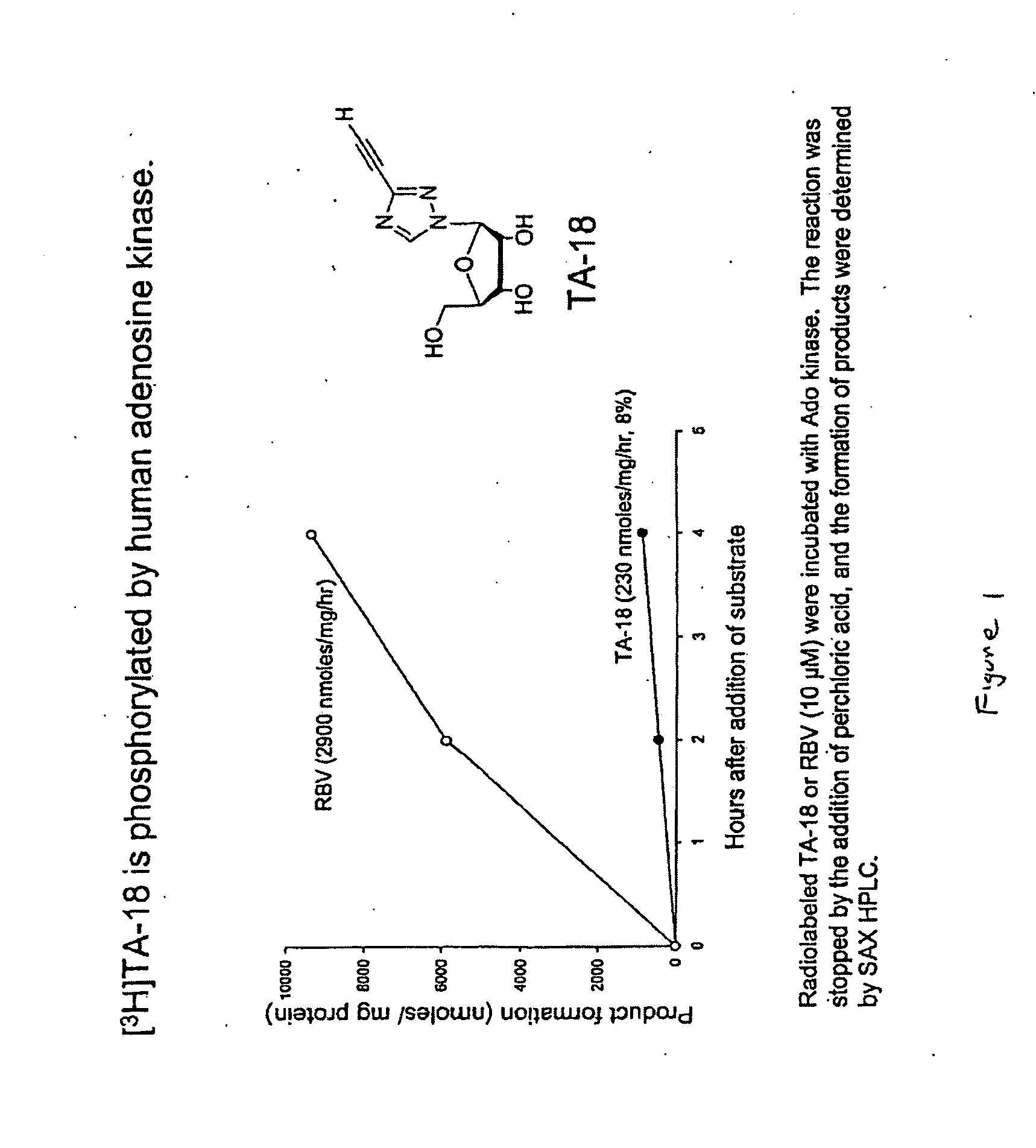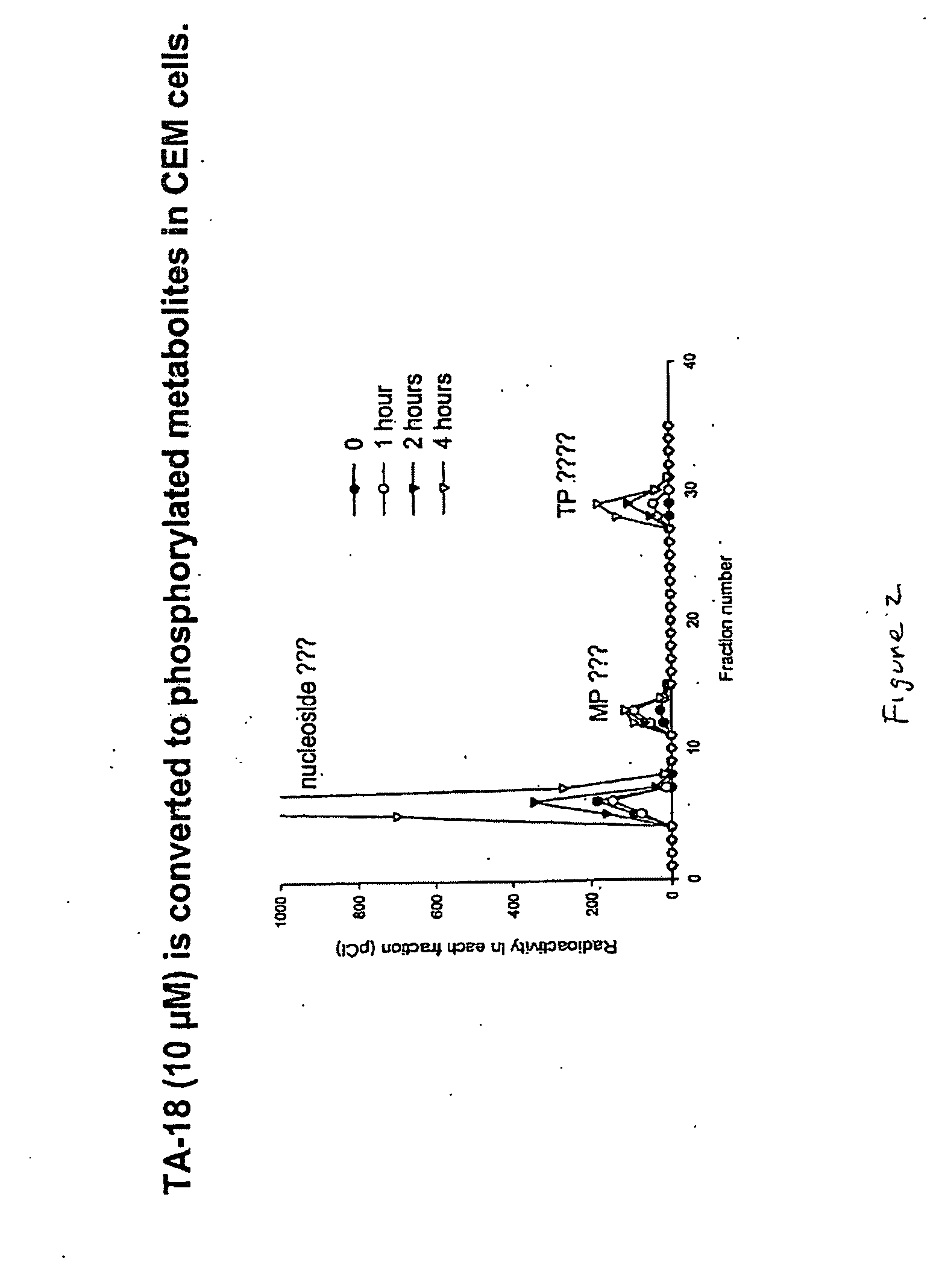Azole nucleosides and use as inhibitors of RNA and DNA viral polymerases
a technology of azole and dna, which is applied in the field of azole, can solve the problems of no good hcv drug, few hbv drugs, and major causes of economic losses in the world, and achieves the effects of reducing the risk of hcv, and reducing the risk of hbv infection
- Summary
- Abstract
- Description
- Claims
- Application Information
AI Technical Summary
Benefits of technology
Problems solved by technology
Method used
Image
Examples
example 2
[0132]
[0133]N1-(3-fluorophenyl)-2′,3′,5′-tris-(O-tert-butyldimethylsilyl)-inosine (TBS-IA-3): To an oven dried Schlenk tube was added TBS-I (2.4 g, 4.0 mmol), 3-fluorophenylboronic acid (1.1 g, 8.0 mmol), anhydrous Cu(OAc)2 (800.0 mg, 4.4 mmol), pyridine-N-oxide (800 mg, 4.0 mmol), ground 4 Å molecular sieves (˜1 g), and a stir bar. The tube was then sealed with a rubber septa and evacuated and flushed with oxygen. Dry pyridine (647 μL, 8.0 mmol) and molecular sieve dried CH2Cl2 (20 mL) were then added and the reaction was stirred vigorously at r.t. for 24 h. The reaction was then quenched with sat. NH4OH in MeOH (0.5 mL in 5 mL respectively) followed by dilution with hexanes to 500 mL. The organics were washed with 250 mL portions of each: water, sat. NH4Cl, 1 M NaCl, and sat. NaCl. The organics were then dried over Na2SO4 and concentrated in vacuo. All compounds were purified by medium pressure flash chromatography (Isco CombiFlash GRADUATE) with CH2Cl2 / MeOH as eluent yielding an...
example 3
[0134]
[0135]N1-(3-fluorophenyl)-inosine (IA-3): To a round bottom flask was added TBS3-IA-3 (1.06 g, 1.5 mmol), dry THF (25 mL), and a stir bar then set to stir at −10° C. To this was added 5.0 mL of 1M tetrabutylammonium fluoride / THF solution and after 1.5 hours (completion indicated by TLC) the solution was directly loaded a 5 cm diameter silica gel gravity column (˜350 mL of 70-230 mesh 60 Å silica gel) with acetone as eluent to remove the bulk of the tetrabutylammonium salts. The solids were then purified by medium pressure flash chromatography (Isco CombiFlash GRADUATE) with toluene / EtOH as eluent yielding an amorphous white solid (F.W.=362.3, 469 mg, 1.29 mmol, 86%) FTIR (KBr, cm−1) 3394, 2931, 1699, 1601, 1578, 1546, 1489, 1226; NMR (CD3OD, 400 MHz) δ 8.39 (1H, s), 8.30 (1H, s), 7.57 (1H, m), 7.35-7.26 (3H, m), 6.04 (1H, d, J=5.9 Hz), 4.63 (1H, m), 4.33 (1H, m), 4.13 (1H, m), 3.86 (1H, m), 3.75 (1H, m); 13C NMR (CD3OD, 400 MHz) δ164.1 (J=245.4 Hz), 157.9, 149.2, 148.7, 141.5,...
example 4
[0136]
[0137]5-amino-4-N-3-fluorophenylcarboxamide-1-β-D-ribofuranosyl-1H-imidazole (RN-3): TBS-IA-3 (1.41 g, 2 mmol) was added to a round bottom flask and dissolved in absolute EtOH (30 mL) and brought to a boil while stirring. 5 N NaOH (10 mL) was then added to the solution, which was refluxed for 4 hrs. The flask was removed from the heat and cooled to r.t. then neutralized (pH=˜7) with 6 N HCl. The aqueous mixture was then extracted with 3 portions EtOAc which were subsequently dried over Na2SO4 and conc. in vacuo. The solids were then recrystallized in EtOAc to afford a slightly pink crystalline solid (F.W.=352.3, 450 mg, 1.28 mmol, 64%) FTIR (KBr, cm−1) 3558, 3536, 3489, 3426, 3363, 3302, 3117, 2938, 2927, 1651, 1607, 1564; 1H NMR (DMSO-d6, 400 MHz) δ 9.57 (1H, br s), 7.79 (1H, m), 7.59 (1H, m), 7.43 (1H, s), 7.27 (1H, m), 6.77 (1H, m), 6.23 (2H, br s), 5.52 (1H, d, J=6.4 Hz), 5.44 (1H, d, J=6.4 Hz), 4.94 (1H, t, J=4.9 Hz), 4.58 (1H, d, J=5.2 Hz), 4.30 (1H, m), 4.05 (1H, m), 3....
PUM
| Property | Measurement | Unit |
|---|---|---|
| diameter | aaaaa | aaaaa |
| temperature | aaaaa | aaaaa |
| weight | aaaaa | aaaaa |
Abstract
Description
Claims
Application Information
 Login to View More
Login to View More - R&D
- Intellectual Property
- Life Sciences
- Materials
- Tech Scout
- Unparalleled Data Quality
- Higher Quality Content
- 60% Fewer Hallucinations
Browse by: Latest US Patents, China's latest patents, Technical Efficacy Thesaurus, Application Domain, Technology Topic, Popular Technical Reports.
© 2025 PatSnap. All rights reserved.Legal|Privacy policy|Modern Slavery Act Transparency Statement|Sitemap|About US| Contact US: help@patsnap.com



